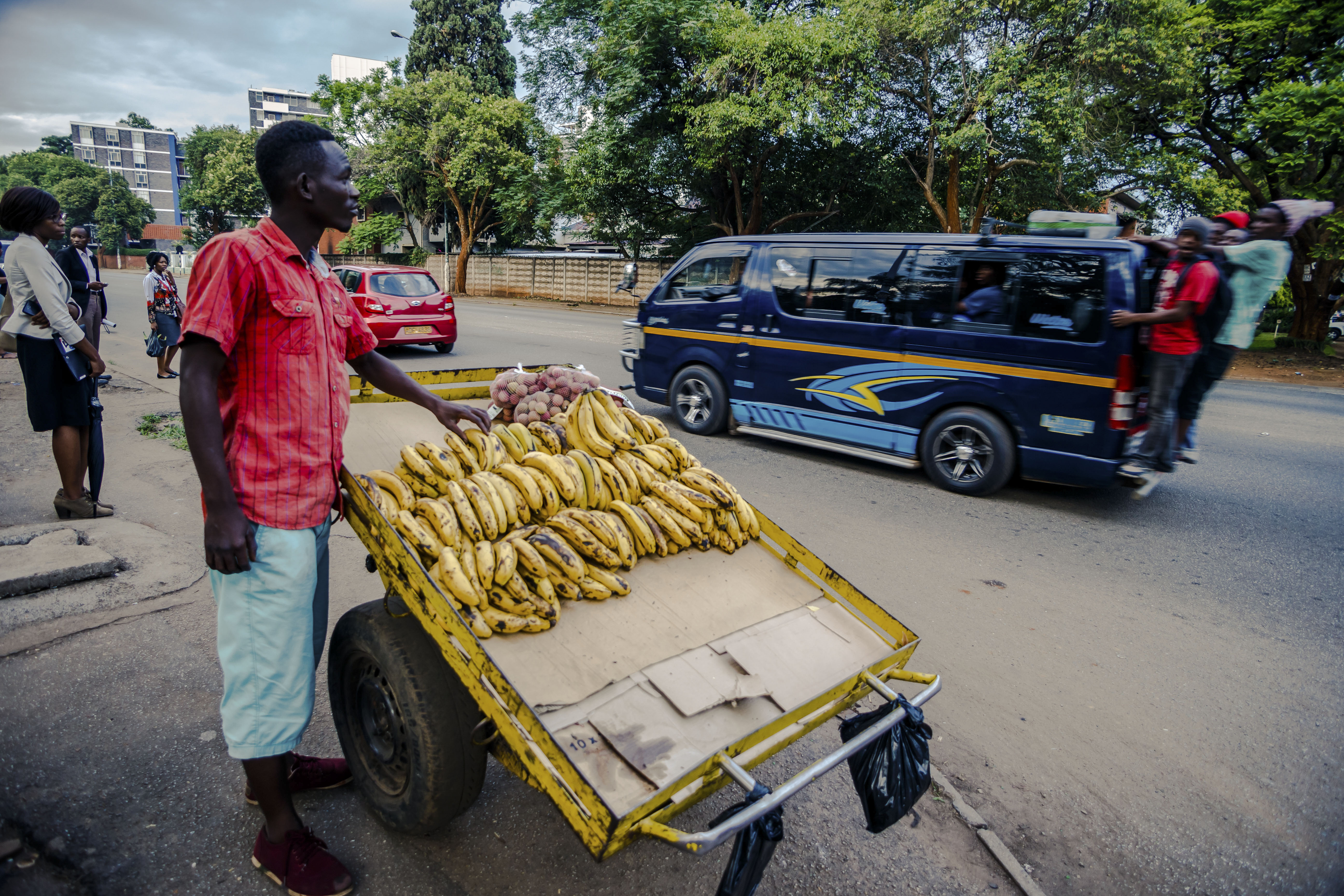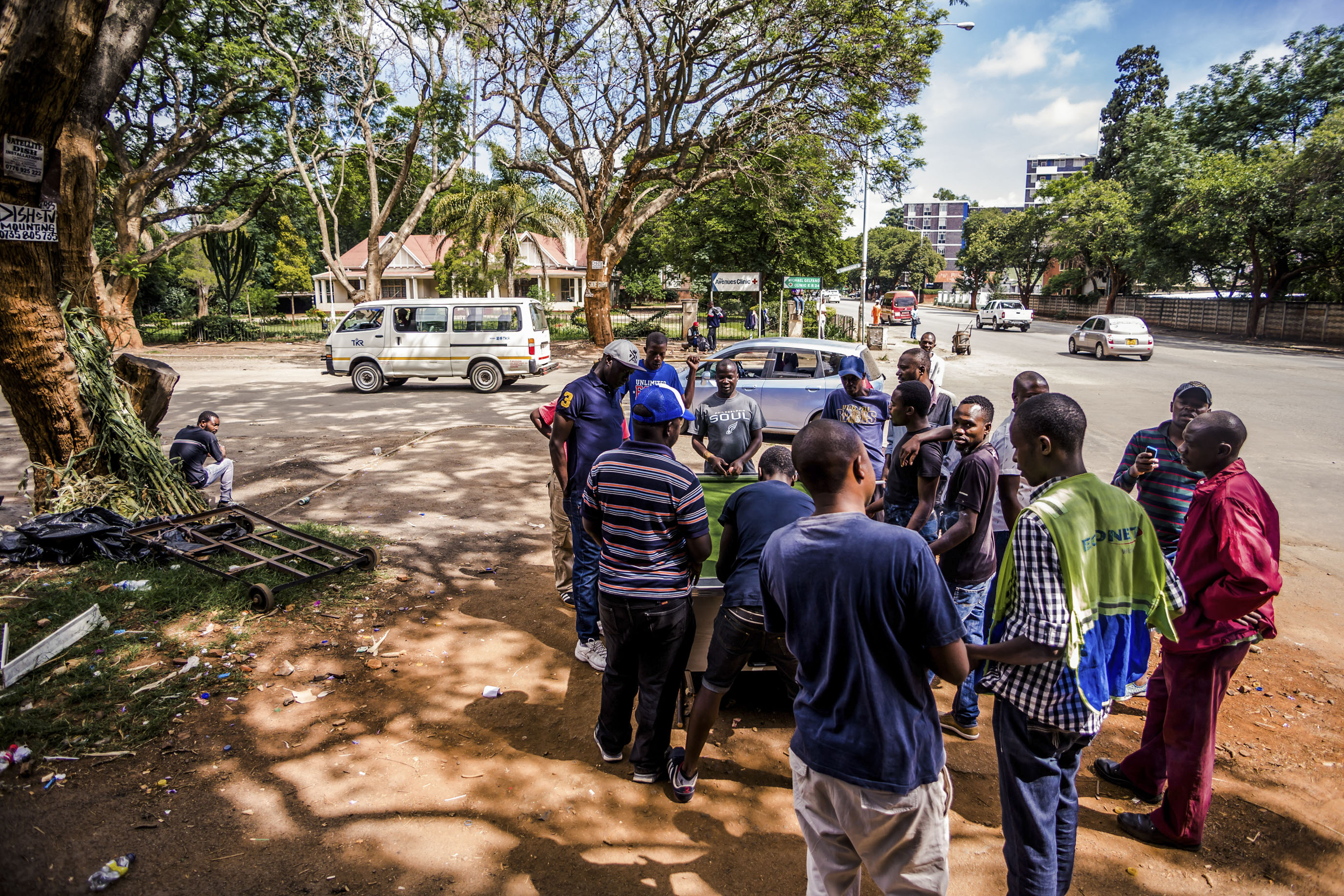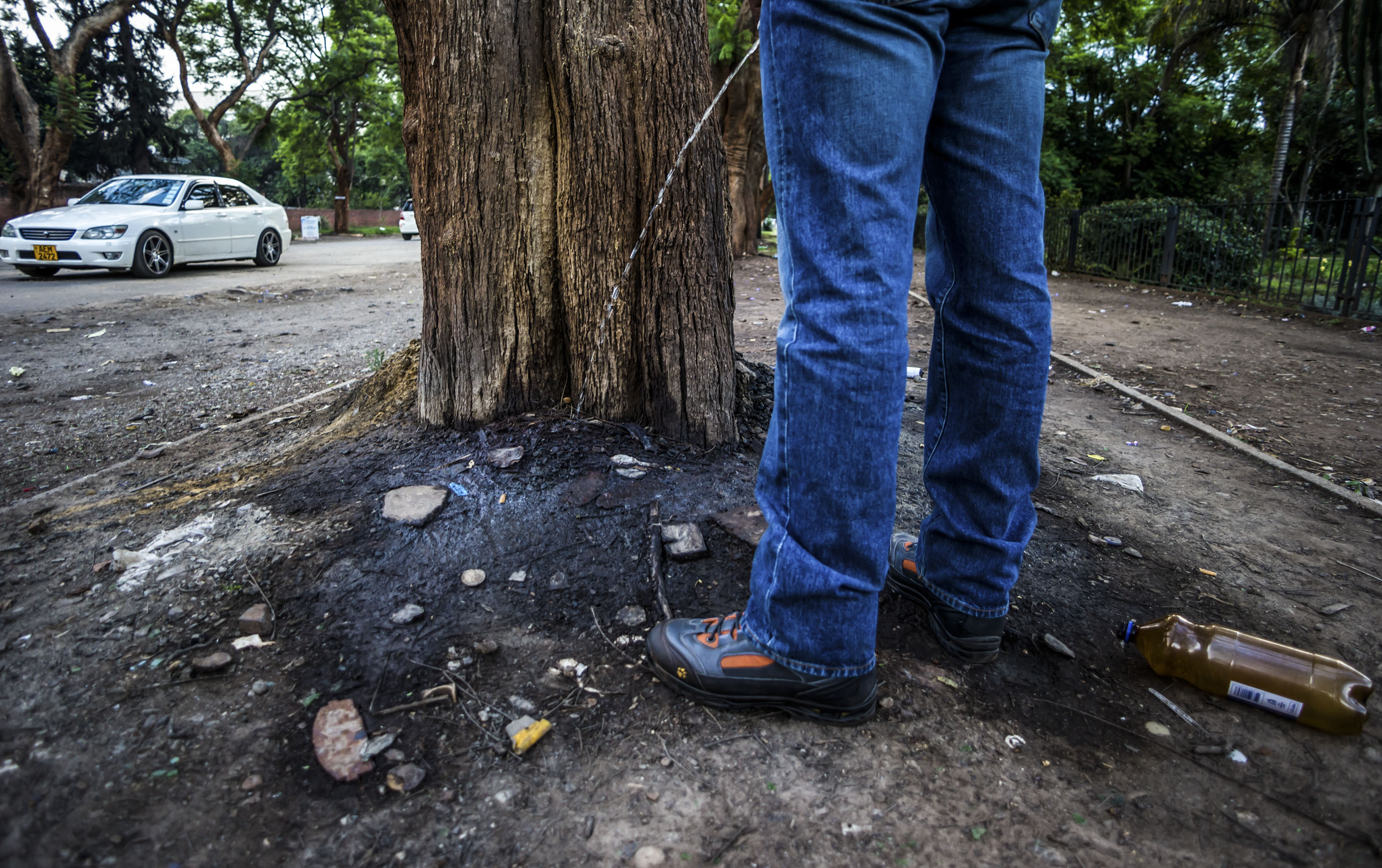Slow death: The jacarandas came out in their purple glory earlier this summer but the tree in the centre didn’t wear its glorious crown this season.
October is the hardest and hottest month in Zimbabwe, the one, according to colonial folklore, in which the most suicides are recorded. But it is also the month when the jacarandas, which line both sides of Josiah Chinamano Avenue and several other streets in Harare, flower into a shimmering purple. Suffusing the air in the vicinity with a royal haze, they supply the ground beneath them with a blue-violet carpet.
But there is one tree that didn’t take part in the visual feast this year. At the corner of Josiah Chinamano Avenue and Sam Nujoma Street, it stands sad, bereft of leaves and with no purple crown. Its base is muddy and streaked with a uric and ashen hue.
It’s just a matter of time before workers from the city’s housing and social services department notice what people who live, work and walk on this street have been aware of for some time — it is dead and should, as Jesus Christ said to the faithful in the Gospels on trees that don’t bear good fruit, be cut down and thrown into the fire.
The tree’s protracted death began in 2015 without much fanfare. Rival groups of taxi touts moved on to the corner of Josiah Chinamano Avenue and Sam Nujoma Street, the heavily canopied neighbourhood just beyond Harare’s central business district and, without public toilets, chose to urinate against this tree. Initially the nitrogen in the urine might have been good for it, which is perhaps the reason envious glances were cast its way by jealous sisters, brothers, lovers and friends, but at some point the urine began to overwhelm the jacaranda.
It was, I guess, what a tout was saying to a colleague one day as I walked by. “The way you pee on this tree, I won’t be surprised if I hear that it is carrying your baby.” The word kutunda, Shona for urinate, is also the same word for ejaculate.

[Branching out: The corner of Josiah Chinamano Avenue and Sam Nujoma Street in Harare has become the gathering point for taxi touts and other traders. (Jekesai Njikizana/iZimPhoto)]
Josiah Chinamano, Herbert Chitepo, Fife, Baines and Josiah Tongogara avenues are lined with low-rise Georgian, Cape Dutch, Modernist and Victorian-style buildings. Some are flats and others have been converted into offices, shops and private hospitals. This neighbourhood, known as the Avenues, marks the transition from Harare’s bustling, black and crowded central business district to the magnetic leafy north and northeast. Mount Pleasant, Emerald Hill, Avondale, Milton Park, Helensvale, Borrowdale, Borrowdale Brooke, Mandara and Greendale — the culmination of middle, upper-middle and upper-class dreams, traditionally white, though since independence in 1980 it has been coloured with brown and black.
Josiah Chinamano is the avenue where the first jacaranda is reputed to have been planted by British settlers in Southern Rhodesia as Zimbabwe was known to them at the time and, in one of history’s rare, neat symmetries, it is perhaps the first time that this tree species has been slowly poisoned by working-class pee.
Long live the people’s pee, long live! I imagine the revolutionary chant would go.
Josiah Chinamano, a street fated to perpetual name changes, is now on its third name (Chinamano was a nationalist in the Joshua Nkomo-led Zimbabwe African People’s Union). Before independence, it was known as Montagu — after Sir Ernest Montagu, a clerk in the British South Africa Company (Cecil Rhodes’s imperial vehicle) and later a secretary of mines. Before that it was known as Cape Avenue.
According to a columnist in the Rhodesian Herald of 1958, “the position of the first jacaranda tree to be planted in Salisbury and so most certainly to be introduced in Southern Rhodesia, has now been established beyond reasonable doubt, according to a Salisbury reader. ‘It stands,’ he says, ‘in the front garden of a small, old-type house on the southeast corner of Montagu Avenue, where it is intersected by Blakiston Street.’
“This property is very appropriately still owned by the British South African Company and until recently was number 13 Montagu Avenue. ‘The final first-hand evidence,’ he says, ‘comes from Mrs Swire-Thompson, who for many years lived in Montagu Avenue almost opposite number 13, and from Lady Flynn, whose house in the same avenue has an entrance-way across Salisbury Street …
“‘Lady Flynn clearly remembers this tree being planted towards the end of 1899 or early in 1900. Mrs Swire-Thompson is quite satisfied that the tree in number 13 was of appreciable height in 1899 and was flowering in 1908’.”
Where the original tree was planted, a property, appropriately enough called the Jacaranda Mews, was developed in 1987. The first jacaranda died in 1998 and, near where it fell, there used to be a plaque that read: “This is believed to be the first jacaranda ever planted in Salisbury or Southern Rhodesia — circa 1900.”

[The first jacaranda planted in Salisbury was on Cape Avenue, which became Montagu Street, which became Josiah Chinamano Avenue. (Jekesai Njikizana/iZimPhoto)]
The planting of the Jacaranda mimosifolia, a tree native to southcentral South America, began in earnest under the direction of Hernon Brown, the curator of Salisbury Gardens, during the 1902-1903 economic depression.
A false alarm had been sounded about the discovery of gold in the area now known as Banket, a small farming town to the northwest of Salisbury (now Harare). “Syndicates were formed and everyone in Salisbury talked [of] nothing but the boom. Those who had savings drew them; housewives used their housekeeping money to buy Banket shares, which soon began to rise spectacularly … No one worried to make enquiries, few even sampled the ground they had pegged, and anyone who did so and could show the slightest tailing of gold was certain of finding a willing purchaser for his claim,” wrote GH Tanser in A Sequence of Time, published in 1974, which traces the early years of life in Salisbury.
After the gold boom proved to be false, and people had counted their losses, a gloom descended on the country. The situation was so bad that hunger and destitution became real, even among Europeans, and the colonial government and the city council, trying to stave off more suffering, decided to find work for these indigents. “The job with the minimum of outlay so far as tools were concerned was tree planting [and] Hernon Brown … had a large number of seedlings.”
So as the rains of 1902 came down, white men started planting trees: flamboyants (Madagascar) on Blakiston Street, jacarandas on Cape Avenue — later Montagu and now Chinamano — and syringas (Asia) and toonas (Asia) on Fife Avenue.
It’s ironic that, more than century later, a different group of indigents suffering under the clueless rule of the now-deposed dictator Robert Mugabe invented work for themselves on the same street but, in a weird application of the dialectic, are killing off the legacy of their indigent European predecessors.
Maybe what is at play is a kind of decolonisation of Zimbabwe’s flora, what Zimbabwean poet and literary scholar Kizito Muchemwa hinted at in his poem Tourists, when he wrote of those who “came into the wilderness clichés in suitcases/ Talismans they cherished as shields against the poisonous madness/ Lurking in the dark aggressive landscape of alienness”. What the tourists were “looking for [was] recognition of this my dear land” but finding no “familiar hills” and hearing no “familiar songs”, they decided to “surround themselves with jacarandas and pines” .
Could it be the death witnessed on Josiah Chinamano is a fulfilment of Muchemwa’s rousing line at the end of his poem in which he writes that “this land, this; the spirits dwelling in it/ Will not yield to such casual intimidation/ Neither will it give out its rich sad secrets/ To half-hearted tokens of transparent love”?
I often wonder about the ghosts and spirits of the disappeared local trees. Perhaps your musasa, munhondo, muzeze and others, which used to be there and which made way for the interlopers, exchange smiles and glances of Schadenfreude as they ponder the fate of the dead jacaranda.

[The reason for the loss of the jacaranda blooms may be that, since 2015, it has been used as a pee post by taxi touts. (Jekesai Njikizana/iZimPhoto)]
In the 2013 elections, trying to win the youth vote, Mugabe, then 89, promised to create more than two million jobs. Given the state of the country’s economy and how, over the past two decades, the country’s once-booming industrial base had atrophied, now resembling a zombie factoryscape, the promise was bold or mad.
It’s not that that promise was out of place, because, depending on who you ask, Zimbabwe’s unemployment rate is mind-bogglingly high or very low. It ranges from more than 80% to just above 10%, the latter according to the government statistical agency. In the agency’s Orwellian definition, for example, a person who was employed in a factory and has been laid off is still officially classified as being employed.
But as the promise of jobs failed to materialise and the country slid into a bottomless abyss, I noticed more and more young men moving on to the corner of Josiah Chinamano Avenue and Sam Nujoma Street to wait for taxis coming from Mazowe, Concession and Bindura.
Sam Nujoma Street, formerly 2nd Street, is wide and connects the outer, southern, rougher edges of the city, near the railway station, to the northern suburbs and, further north, with Mazowe, citrus country, where oranges, which make the iconic Mazoe juice, are grown.
One tout and a driver told me most of these men used to work in offices and factories or came from the rural areas to try to make a living in the city, the epicentre of the country where, the saying goes, if you have a plan, you can at least get by. These people — university graduates, peasants, skilled and unskilled workers and other categories allocated to them by capital — are the fulfilment of the jobs promise. A Zanu-PF MP clarified that, when the government said it would create two million jobs, itdidn’t mean just formal jobs.
The touts might be smoking a joint, trying to chat up a sex worker, whose own base is down the street, drinking the traditional Chibuku Super beer (although their favourite poison is Two Keys whisky) or eating pap and meat, but when they see a taxi driving down from the north, they drop everything, duck oncoming traffic and flag it down.
The taxi will stop, the driver will get down and one of the touts will get in the driver’s seat while his two companions get inside the taxi (if there is space) or hang precariously from the back of the taxi — a daredevil manoeuvre that has earned them the moniker “Spiderman”.
If ever there was a metaphor that encapsulates the disdain Mugabe’s Zimbabwe had for its youth, this is it. If the tout slips and falls, he is certain to be knocked down by traffic coming from behind, resulting in death or grave injury. I have heard of taxi touts falling and dying but I haven’t been able to establish the truth of this.
When the taxi gets into the busy city centre, where we say in Shona you can’t call at anyone and be heard, they quickly offload the passengers. But, instead of sitting in the designated ranks waiting for passengers to get in, the three will drive up and down streets such as Julius Nyerere Avenue to hustle for passengers while dodging municipal and the national traffic cops.
That is when you see that these young men are the city’s foremost entreprenuers. They are part inventors (of new perilous ways of negotiating the city’s roads, including doing U-turns in front of oncoming traffic), part delinquent (as they drive vehicles of questionable roadworthiness), part legislators (they have unilaterally allocated themselves rights of where to park and load) and part purveyors of the city’s zeitgeist. Whatever new trends, new lingo and new ways of being in the city, these young men are there first.
The minibuses are embossed with whatever new slogan or phenomenon has caught the fancy of Harareans. You might see the words “Stamford Bridge”, “Zlatan” or “Iwobi” to acknowledge the popularity of the English Premier League in Zimbabwe, “Better Days Will Come”, a reference to Mugabe’s ruinous policies and optimism for the troubled country, or “Mwendamberi”, a nod at clan-based identities of old.
Their sound systems are perhaps the biggest purveyors of a dancehall/ragga sound sung mostly in Shona, known as Zim dancehall. This has been played so much that we all have had no choice but to like it.
How quickly a taxi is filled depends on the day, time of day, week or month and can take between less than 30 minutes to several hours. Payday “week” (which stretches from about the 25th of the month to the early days of the following month) is the busiest time. The touts, for their troubles, each get $3. On a good day, a tout can earn as much as $20.
Some months ago, I sat down with a taxi driver while he related what happens on a typical day, the difficulties of the job and how he negotiates its various pitfalls.
In the hustle to get people into the taxi, the most difficult hurdle is getting the first and the last passengers. In the family and in our daily lives, the person who is first and the person who is last occupy an undisputed place of honour. Whatever privileges come with being the firstborn in a family, when translated to a taxi, become a tad problematic — no one wants to be the first passenger in an empty taxi or, it seems, to sit at the back of the taxi. To get around this desire not to be first, people are hired to sit in the taxi pretending to be travellers, an exercise known as “kujegera”. As the taxi fills up with real travellers, the decoys step out.
Then comes the time when the taxi needs just one more passenger, which can be fateful. As the driver is waiting, revving the engine in pretend-departure manner and the tout is shouting at passers-by, “hwani asara weku Bindura” (“only one passenger to Bindura and we are good to go”), bad luck strikes — a municipal cop in mufti. Pretending to be a passenger, he tells the driver: “You are under arrest for loading passengers in an undesignated area.”
This ordeal normally ends in a fine or a bribe. But, however it ends, the driver and tout will soon be back on Josiah Chinamano Avenue, drinking Chibuku Super (certainly not the pricier Two Keys whisky), complaining about corrupt cops and the perils of living in Mugabe’s Zimbabwe, while they wait for the next taxi.
When the touts feel like urinating, it is done on the dead jacaranda tree. But the tree and its vicinity are becoming almost unapproachable because of the smell, and the touts have moved on to the two trees next to it.
If Zimbabwe’s economic fortunes turn around under the new president, Emmerson Mnangagwa, one way of measuring success will be how many of this lost generation (une génération perdue, in the words of American writer Gertrude Stein) he manages to remove from these streets and place in jobs in government, the mines, on farms and in factories. The turnaround won’t only be good for these youths whose future was bleak under Mugabe but also for the jacarandas on Josiah Chinamano Avenue.
Percy Zvomuya is a writer and football fan. The book Historic Trees of Zimbabwe by LJ Mullin was invaluable in the writing of this piece